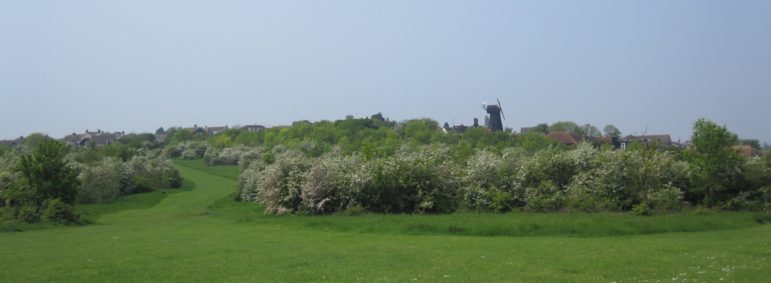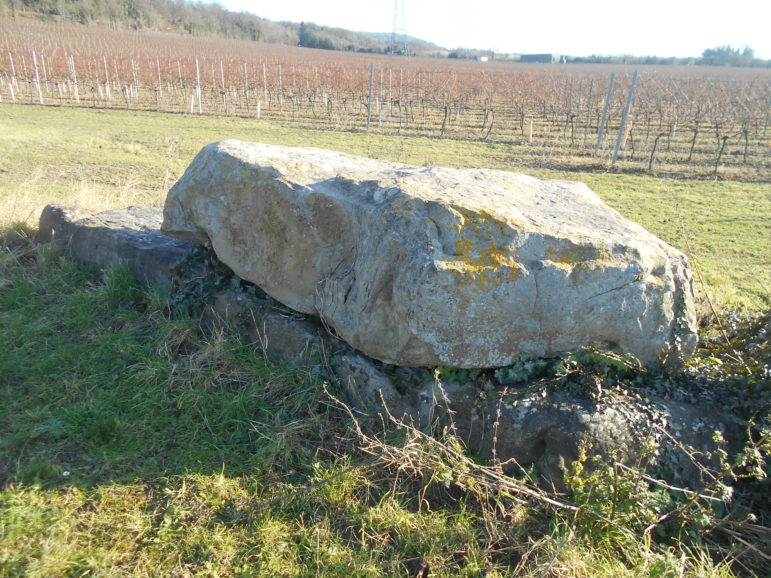WHITSTABLE, England – Last week, TWH reported on the green light for plans to go ahead with the controversial Stonehenge tunnel, but this week has seen henge-related news of a different variety: the establishment of a new stone circle on a village green in Kent.

A view across part of Duncan Down – Image credit: Prl42 – CC BY-SA 3.0,
The village green is part of Duncan Down, and located just south of the seaside town Whitstable, north coast of Kent in south-east England, and 5 miles north of Canterbury. Being the country’s largest village green, it is not un-noteworthy, but putting a stone circle on it is still ambitious.
The motivations behind the erection of the great ancient circles of Stonehenge and Avebury remain mysterious and a matter for speculation: not so the Whitstable circle, which was erected as a “symbol of permanence” for the new Gorrell Valley Nature Reserve.
Councillor Ashley Clark, one of the people behind the circle, said, “It has no religious or political symbolism – just a quiet place for reflection.”
And whereas our ancient ancestors labored for many years to set up the great henges, in some cases bringing stones hundreds of miles across a wild country, the Whitstable version was set up last Thursday.
Clark told the press that, “Cost was minimal because the labour of the volunteers comes at no charge,” adding that, “The ground was like concrete so we had to wait for the rain to get digging.”
The new circle does bear some resemblance to its ancient cousins, however, in that it marks the four points of the compass and in addition, is aligned with the summer and winter solstices. A central stone has a time capsule buried beneath it.
Clark explained how the site was chosen, “We selected that particular site as it has a view of the old windmill and the new offshore wind farm – so it has elements of past, present and future. And the theme that life is a partnership between those who were here, those who are here today and those yet to be born in the hope that they will continue to protect this space for nature and the peaceful enjoyment of local people.”
It is to be hoped that Kent’s Pagans will be able to make use of the new circle. This addition to the family of Britain’s stone circles is not unique: there are many in England as well as Wales. Sentry Circle in Yorkshire, for example, was erected by the landowner, farmer Derek Plews, in 2009.
Plews said at the time, “It is not about money. This is not a replica of Stonehenge, it is a new stone circle, which is lined up with the stars. It is a really spiritual place. It is not a tourist attraction. It is somewhere sacred.”
Elsewhere in Great Britain, new monuments are more common. Wales is particularly prolific when it comes to new monuments since circles are set up in towns after the big Welsh language cultural events known as the Eisteddfods.
Tej Turner, a Pagan living in South Wales, told TWH, “I don’t really have much opinion on them either way… They are so common you barely notice them eventually. I do like to troll my friends by convincing them that they are genuine Bronze Age relics sometimes though.”
The county of Kent had no stone circles, until now, in ancient times it was covered in deciduous woodland.
However, it nonetheless has some genuinely old monuments of its own. The so-called Medway Megaliths, a number of chambered long barrows which stand on either side of the river Medway. These are less well known in comparison to their equivalents on the other side of the country; the Cotswold- Severn group across Gloucestershire and Wiltshire, such as Wayland’s Smithy.
Yet they are still archaeologically significant and a focus for modern Pagan worship. Groups meet regularly and there is an annual celebration there on May Day, including a Morris team. There are also other stones are situated on private land, but can be visited by arrangement.
Other stones include Kit Coty’s House, Little Kit Coty’s House, and the Coffin Stone, some of which are subject to local folklore. A baker is supposed to have tried to count the stones of Little Kit Coty’s House by placing a loaf of bread on each stone, but just as he neared the end of the counting process, a loaf disappeared and the Devil manifested in its place (uncountable stones and yew trees are a feature of British folklore and stories about them are found across the country).
Two human skulls were found beneath the Coffin Stone in the 19th Century and it is likely that this was some form of ancient burial place. The stone itself is now in the middle of one of Kent’s vineyards.

The Coffin Stone, in a vineyard near Blue Bell Hill in Kent, England. Sarsten stones possibly moved from a former neolithic burial chamber nearby. Image credit: Simon Burchell – CC BY-SA 4.0
Elsewhere in the county, the White Horse Stone is also a center of contemporary Pagan worship, mainly by those who follow Anglo-Saxon traditions. The stone, which was probably part of a greater monument which has since been destroyed, is said to have gained its name when a banner featuring a white horse was found near it after the Battle of Aylesford in 455.
Saxon invaders Hengist and Horsa were said to have carried the banner – but this, again, is a piece of folklore rather than a historically accurate surmise. However, excavations near the White Horse Stone have uncovered a very old timber structure, around 5000 years old, and there has been speculation that this may have been a center of worship of some kind, due to its proximity to the monument.
The Stour valley also has a number of long barrows, Juliberrie’sGrave, Boughton Aluph, and Elmstead, but these are earthen. In addition, there are several causewayed enclosures in the county. Finds, such as stone axes, show the extent to which the tribes of Kent traded with other parts of the country.
However, an explorer’s hat would be needed for anyone who intends to visit some of these monuments. Some, as mentioned, are on private land and unlike the greater henges elsewhere, none of these have been turned into a tourist attraction. The Coldrum Stones have a car park, but the other stones are in remoter locations and are not well signposted.
It is likely that in addition to these ancient stones, Kent’s Pagan community will lose no time in making use of the latest circle at Whitstable.
The Wild Hunt is not responsible for links to external content.
To join a conversation on this post:
Visit our The Wild Hunt subreddit! Point your favorite browser to https://www.reddit.com/r/The_Wild_Hunt_News/, then click “JOIN”. Make sure to click the bell, too, to be notified of new articles posted to our subreddit.
